
Bees are winged insects closely related to wasps and ants, known for their roles in pollination and, in the case of the best-known bee species, the western honey bee, for producing honey. Bees are a monophyletic lineage within the superfamily Apoidea. They are presently considered a clade, called Anthophila. There are over 16,000 known species of bees in seven recognized biological families. Some species – including honey bees, bumblebees, and stingless bees – live socially in colonies while most species (>90%) – including mason bees, carpenter bees, leafcutter bees, and sweat bees – are solitary.

A honey bee is a eusocial flying insect within the genus Apis of the bee clade, all native to mainland Afro-Eurasia. After bees spread naturally throughout Africa and Eurasia, humans became responsible for the current cosmopolitan distribution of honey bees, introducing multiple subspecies into South America, North America, and Australia.

Beekeeping is the maintenance of bee colonies, commonly in man-made beehives. Honey bees in the genus Apis are the most commonly kept species but other honey producing bees such as Melipona stingless bees are also kept. Beekeepers keep bees to collect honey and other products of the hive: beeswax, propolis, bee pollen, and royal jelly. Pollination of crops, raising queens, and production of package bees for sale are other sources of beekeeping income. Bee hives are kept in an apiary or "bee yard".
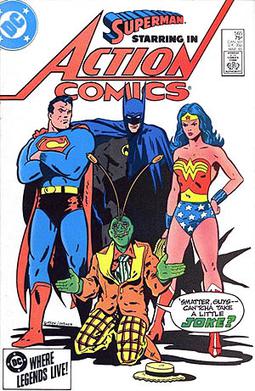
Ambush Bug is a superhero appearing in American comic books published by DC Comics. His real name is supposedly Irwin Schwab, but he has mental problems that prevent him from truly understanding reality around him, so even his true identity might be no more than a delusion on his part. His origin is disputed, although the most commonly accepted origin is that Brum-El of the planet Schwab sent his clothes from his supposedly doomed planet, hoping that his wardrobe would survive, only to have it intercepted by a giant radioactive space spider. In the resulting crash, only two articles of clothing survived: the Ambush Bug suit, which was subsequently found by Irwin Schwab; and "Argh!Yle!", an argyle sock with a Doctor Doom-like complex, complete with metal mask.

Bat-Mite is a fictional character appearing in American comic books published by DC Comics. Bat-Mite is an imp similar to the Superman villain Mister Mxyzptlk. Depicted as a small, childlike man in an ill-fitting Batman costume, Bat-Mite possesses what appear to be near-infinite magical powers, but he actually uses highly advanced technology from the fifth dimension that cannot be understood by humans' limited three-dimensional views. Unlike Mxyzptlk, Bat-Mite idolizes his superhero target and thus he has visited Batman on various occasions, often setting up strange and ridiculous events so that he could see his hero in action. Bat-Mite is more of a nuisance than a supervillain, and often departs of his own accord upon realizing that he has angered his idol.

Varroa destructor, the Varroa mite is an external parasitic mite that attacks and feeds on the honey bees Apis mellifera and Apis cerana. The disease caused by the mites is called varroosis.

Alexander Cannon is an American cartoonist, known for his work on books such as Top 10, Smax and Kaijumax.

Apis dorsata, the rock bee or giant honey bee, is a honey bee of South and Southeast Asia. They are typically around 17–20 mm (0.7–0.8 in) long and nests are mainly built in exposed places far off the ground, like on tree limbs, under cliff overhangs, and under buildings. These social bees are known for their aggressive defense strategies and vicious behavior when disturbed. Though not domesticated, indigenous peoples have traditionally used this species as a source of honey and beeswax, a practice known as honey hunting.

Jim Ottaviani is an American writer who is the author of several comic books about the history of science. His best-known work, Two-Fisted Science: Stories About Scientists, features biographical stories about Galileo Galilei, Isaac Newton, Niels Bohr, and several stories about physicist Richard Feynman. He is also a librarian and has worked as a nuclear engineer.
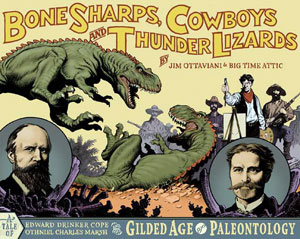
Bone Sharps, Cowboys, and Thunder Lizards: A Tale of Edward Drinker Cope, Othniel Charles Marsh, and the Gilded Age of Paleontology is a 2005 graphic novel written by Jim Ottaviani and illustrated by the company Big Time Attic. The book tells a fictionalized account of the Bone Wars, a period of intense excavation, speculation, and rivalry in the late 19th century that led to a greater understanding of dinosaurs and other prehistoric life. Bone Sharps follows the two scientists Edward Drinker Cope and Othniel Marsh as they engage in an intense competition for prestige and discoveries in the western United States. Along the way, the scientists interact with historical figures of the Gilded Age, including P. T. Barnum and Ulysses S. Grant.

Deformed wing virus (DWV) is an RNA virus, one of 22 known viruses affecting honey bees. While most commonly infecting the honey bee, Apis mellifera, it has also been documented in other bee species, like Bombus terrestris, thus, indicating it may have a wider host specificity than previously anticipated. The virus was first isolated from a sample of symptomatic honeybees from Japan in the early 1980s and is currently distributed worldwide. It is found also in pollen baskets and commercially reared bumblebees. Its main vector in A. mellifera is the Varroa mite. It is named after what is usually the most obvious deformity it induces in the development of a honeybee pupa, which is shrunken and deformed wings, but other developmental deformities are often present.
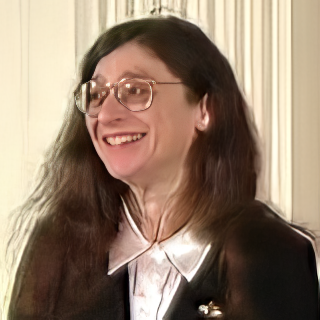
May Roberta Berenbaum is an American entomologist whose research focuses on the chemical interactions between herbivorous insects and their host plants, and the implications of these interactions on the organization of natural communities and the evolution of species. She is particularly interested in nectar, plant phytochemicals, honey and bees, and her research has important implications for beekeeping.
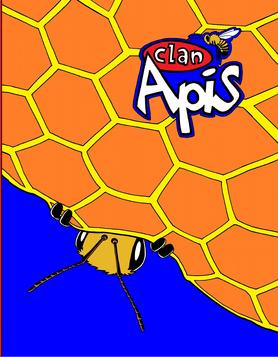
Clan Apis is a graphic novel created by then Assistant Professor of Biology at Juniata College, Jay Hosler. It was originally published by Active Synapse in 1998 as five comic books, and as a single graphic novel in 2000. The novel follows the life story of a honey bee named Nyuki learning about her purpose in the vast world of insects.

Colony collapse disorder (CCD) is an abnormal phenomenon that occurs when the majority of worker bees in a honey bee colony disappear, leaving behind a queen, plenty of food, and a few nurse bees to care for the remaining immature bees. While such disappearances have occurred sporadically throughout the history of apiculture, and have been known by various names, the syndrome was renamed colony collapse disorder in early 2007 in conjunction with a drastic rise in reports of disappearances of western honey bee colonies in North America. Beekeepers in most European countries had observed a similar phenomenon since 1998, especially in Southern and Western Europe; the Northern Ireland Assembly received reports of a decline greater than 50%. The phenomenon became more global when it affected some Asian and African countries as well.
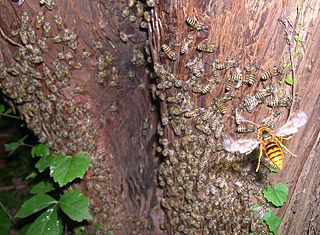
Apis cerana japonica is a subspecies of the eastern honey bee native to Japan. It is commonly known as the Japanese honey bee. This subspecies was determined, through an analysis of mitochondrial DNA, to have originally come from the Korean peninsula. They have been observed moving into urban areas in the absence of natural predators.
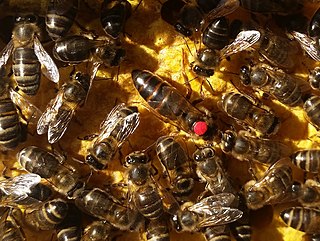
Apis mellifera intermissa is an African subspecies of the western honey bee.

Robert E. Page Jr. is one of the foremost honey bee geneticists in the world and a Foundation Chair of Life Sciences of Arizona State University. An author of more than 250 research papers and articles, his work on the self-organizing regulatory networks of honey bees has been outlined in his book, "The Spirit of the Hive: The Mechanisms of Social Evolution," published by Harvard University Press in 2013. Page currently holds the titles of Arizona State University Provost Emeritus and Regents Professor Emeritus. He is also chair and professor emeritus at the University of California-Davis and an external professor at the Santa Fe Institute.

The Sandwalk Adventures is a graphic novel created by Assistant Professor of Biology at Juniata College, Jay Hosler. It was originally published in 2001 as five comic books, and republished as into a single graphic novel in 2003. The Sandwalk Adventures is the tale of follicle mites living in the left eyebrow of Charles Darwin himself. The mites believe Darwin to be a god, one of their creation myths handed down from generation to generation, and he has to set them straight about that and other mite fables. A humorous series of illustrated lessons in natural selection and evolution ensues.


















